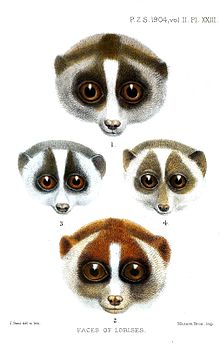Lorisis thecommon namefor thestrepsirrhinemammalsof the subfamilyLorinae[1](sometimes spelledLorisinae[2]) in the familyLorisidae.Lorisis one genus in this subfamily and includes theslender lorises,Nycticebusis the genus containing theslow lorises,andXanthonycticebusis the genus name of thepygmy slow loris.
| Lorises Temporal range:Mioceneto present
| |
|---|---|

| |
| Joseph Smit'sFaces of Lorises(1904) | |
| Scientific classification | |
| Domain: | Eukaryota |
| Kingdom: | Animalia |
| Phylum: | Chordata |
| Class: | Mammalia |
| Order: | Primates |
| Suborder: | Strepsirrhini |
| Family: | Lorisidae |
| Subfamily: | Lorinae Gray,1821[1] |
| Genera | |
| Synonyms | |
| |
Description
editLorises arenocturnalandarboreal.[3]They are found intropicaland woodland forests of India, Sri Lanka, and parts ofsoutheast Asia.Their locomotion is a slow and cautious climbing form ofquadrupedalism.Some lorises are almost entirelyinsectivorous,while others also includefruits,gums,leaves,andslugsin their diet.[4][page needed]
Lorises, like most strepsirrhines, have a special adaptation called a "toothcomb"in their lower front teeth, which they use for grooming their fur and even injecting their venom.[5]
Female lorises practiceinfant parking,leaving their infants behind in trees or bushes. Before they do this, they bathe their young withallergenicsalivathat is acquired by licking patches on the insides of their elbows which produce a mild toxin that discourages mostpredators,[4]thoughorangutansoccasionally eat lorises.[6]
Taxonomic classification
editThe family Lorisidae is found within theinfraorderLemuriformesandsuperfamilyLorisoidea,along with the family Galagidae, thegalagos.This superfamily is a sister taxon of Lemuroidea, thelemurs.Within Lorinae, there are ten species (and several more subspecies) of lorises across three genera:[1]
- FamilyLorisidae
- SubfamilyPerodicticinae
- Subfamily Lorinae
- GenusLoris
- Gray slender loris,Loris lydekkerianus
- Highland slender loris,L. lydekkerianus grandis
- Mysore slender loris,L. lydekkerianus lydekkerianus
- Malabar slender loris,L. lydekkerianus malabaricus
- Northern Ceylonese slender loris,L. lydekkerianus nordicus
- Red slender loris,L. tardigradus
- Dry Zone slender loris,L. tardigradus tardigradus
- Horton Plains slender loris,L. tardigradus nyctoceboides
- Gray slender loris,Loris lydekkerianus
- GenusXanthonycticebus[7]
- Pygmy slow loris,X. pygmaeus
- GenusNycticebus
- Bangka slow loris,Nycticebus bancanus
- Bengal slow loris,N. bengalensis
- Bornean slow loris,N. borneanus
- Sunda slow loris,N. coucang
- Javan slow loris,N. javanicus
- Kayan River slow loris,N. kayan
- Philippine slow loris,N. menagensis
- Sumatran slow loris,N. hilleri
- †?N. linglom(fossil,Miocene)
- GenusLoris
References
edit- ^abcGroves, C. P.(2005).Wilson, D. E.;Reeder, D. M. (eds.).Mammal Species of the World: A Taxonomic and Geographic Reference(3rd ed.). Baltimore: Johns Hopkins University Press. pp. 122–123.ISBN0-801-88221-4.OCLC62265494.
- ^Brandon-Jones, D.; Eudey, A. A.; Geissmann, T.; Groves, C. P.; Melnick, D. J.; Morales, J. C.; Shekelle, M.; Stewart, C.-B. (2004)."Asian Primate Classification"(PDF).International Journal of Primatology.25(1): 100.doi:10.1023/b:ijop.0000014647.18720.32.S2CID29045930.
- ^Ronald M. Nowak; Ernest Pillsbury Walker (28 October 1999).Walker's Primates of the World.JHU Press.ISBN978-0-8018-6251-9.
loris OR lorises.
- ^abJurmain, Robert; Kilgore, Lynn; et al. (2008).Introduction to Physical Anthropology.ISBN978-1337099820.
- ^Nekaris, K A I (2014). "Extreme primates: Ecology and evolution of Asian lorises".Evol Anthropol.23(5): 177–87.doi:10.1002/evan.21425.PMID25347976.S2CID1948088.
- ^"Orangutan Ecology".Orangutan Foundation International.Retrieved2014-01-14.
- ^Nekaris, K. Anne-Isola; Nijman, Vincent (2022-03-23)."A new genus name for pygmy lorises, Xanthonycticebus gen. nov. (Mammalia, primates)".Zoosystematics and Evolution.98(1): 87–92.doi:10.3897/zse.98.81942.ISSN1860-0743.S2CID247649999.
External links
editData related toLorisat Wikispecies